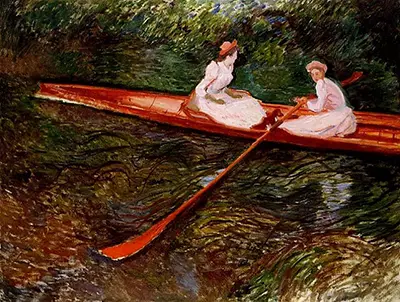The eye is drawn, at first, to two young women on a boat, starkly pale and crisp against a swampy, swirling background of green river water. The angular lines of their boat separate them from the water’s murk, both literally and figuratively.
Man made from natural wood, earth toned yet bright against the background, the pink skiff itself belongs neither to the young girls who steer it nor to the river it floats upon. Instead it acts as a bulwark between a world of bourgeoisie niceties and the untamed wilds of nature.
In June 1890, Monet wrote in a letter, "I have again taken up things impossible to do: water with grass waving in its depths...". It comes as no surprise that The Pink Skiff was painted that same year - it perfectly captures the motion of fronds beneath the water’s surface and the way these are refracted by light, creating a slurring, listing effect that almost leaves the viewer seasick.
The sense of being off balance is enhanced by the sharp angle at which the pink skiff cuts across the canvas, with its long oars akimbo. In The Pink Skiff, a perfectly ordinary scene of everyday life in the village of Giverny is given a sense of muted menace and unease that makes the viewer wonder what lies beneath.
Monet was a collector of Japanese woodblock prints, known as 'ukiyo-e' - many of the prints in his collection still hang on the walls of his house in Giverny. A number of critics have noticed the influence of Japanese woodblock artists on Monet’s later works, and The Pink Skiff is a particularly interesting example.
Immediate parallels can be drawn between this painting and Utagawa Kunisada's Abalone Fishing (early 1830s) - the colour palette is similar, as is the way a boat is angled into a river scene and the way in which water ripples over weeds. The sense of space in The Pink Skiff might also remind the viewer of Utagawa Hiroshige's Full Blossom at Arashiyama (c. 1834), which also looks down on a boat on a river, placed in the corner of the frame.
The Pink Skiff might be seen as Monet's interpretation of the Japanese pastoral, filtered through his own middle-class French perspective and brought to life with his carefully honed Impressionist technique which makes use of deft, spontaneous brushstrokes to create a sense of movement and vitality. Van Gogh had a similar interest in Japanese art as seen in Almond Branches in Bloom.
The Pink Skiff was one of Monet’s last paintings to feature human figures - from that point on, the artist was much more interested in expressing the emotions of nature rather than people, perhaps because it presented a greater challenge which Impressionist techniques were perfectly suited to solve.
Certainly in The Pink Skiff, it’s the eddying waters which draw us into their depths, inviting us to dive in and explore while the stiff, pale rowers can only look on from a careful distance.


